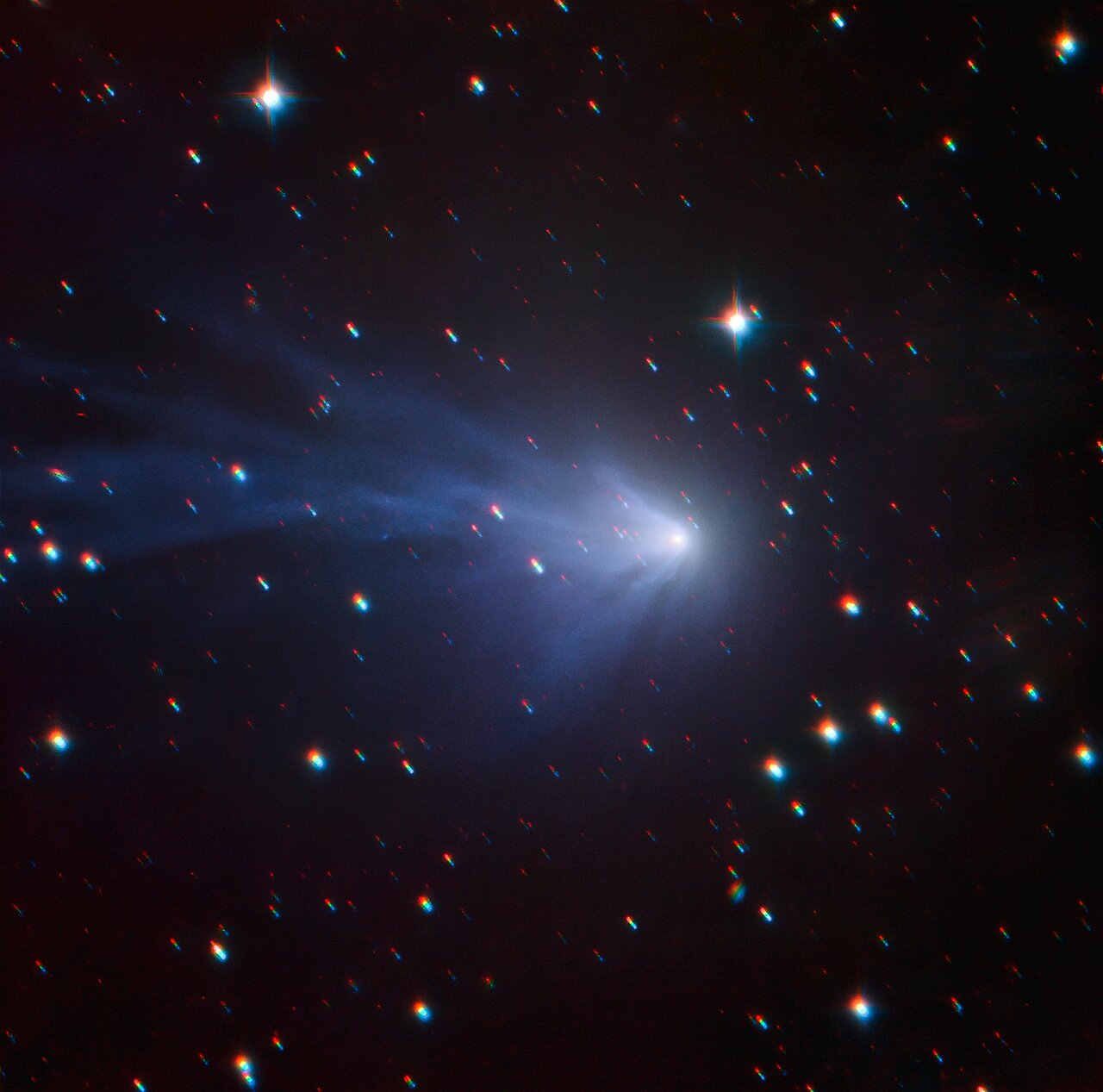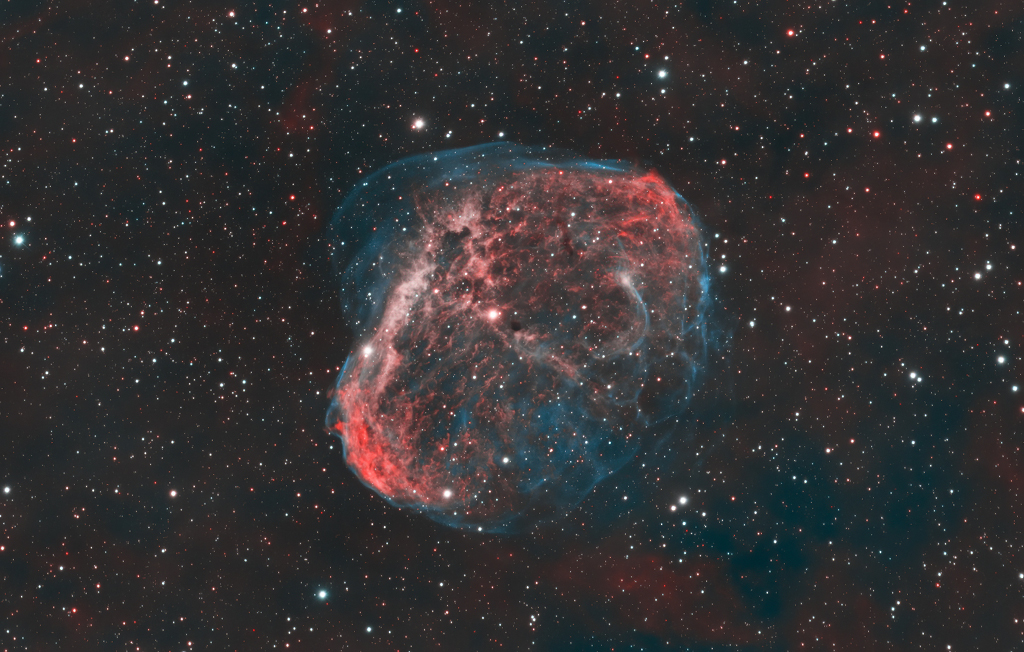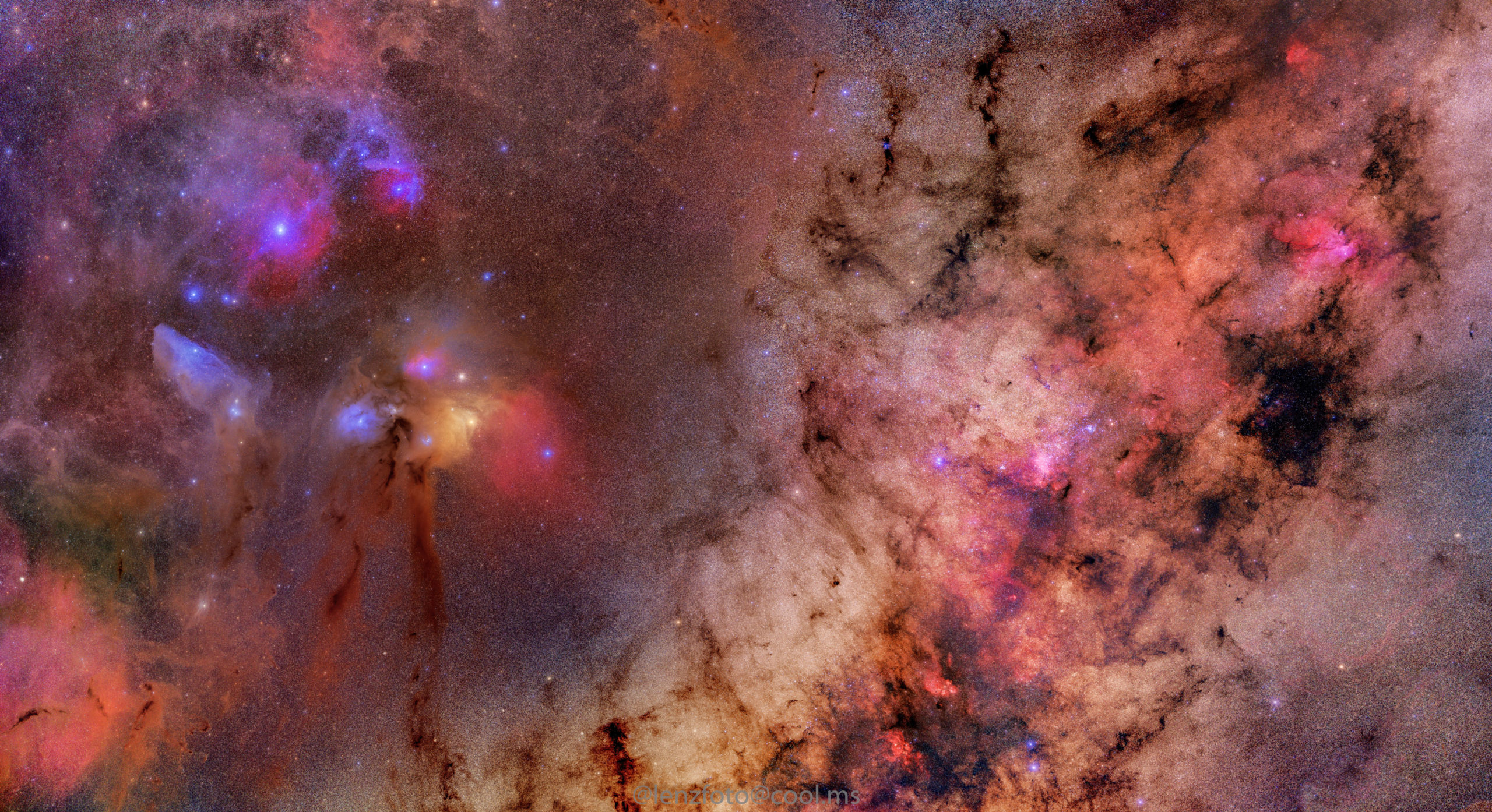Blog
Marking this National Holiday today in History commemorating the EmancipationProclamation issued in 1865 finally!

more...
This image features a comet located in the outer reaches of the Solar System: comet C/2016 R2 (PANSTARRS). As its name suggests, the comet was discovered in 2016 by the Pan-STARRS telescopes in Hawai’i. The new image seen here was captured by a project based at ESO’s Paranal Observatory in Chile named the Search for habitable Planets EClipsing ULtra-cOOl Stars — or SPECULOOS for short. Comets are balls of dust, ice, gas and rock. When they pass close to the Sun, their ice warms up, turns to gas, and escapes in a process called “outgassing”. This process forms fuzzy envelopes around the comets’ nucleus, called comas, and distinctive tails. Observations from SPECULOOS show that the tail of C/2016 R2 (PANSTARRS) changes dramatically across a single night, making for a dynamic set of images. The image shown here, and accompanying frames in the time-lapse movie, comprise observations taken on 18 January 2018 during the test phase of SPECULOOS’s Callisto telescope, and were taken when the comet was 2.85 AU from the Sun (1 AU being the Earth-Sun distance) and travelling inwards. This comet is particularly exciting because of the rare compounds and molecules that scientists have detected in its coma: carbon monoxide and nitrogen ions. These compounds give the comet distinctive blue emission lines — so much so that it is nicknamed “the blue comet”. This shy comet only orbits the Sun once every 20 000 years, its most recent approach being in May 2018. This image was taken over a period of time as the telescope tracked the comet’s motion; the bright streaks of light in the background are faraway stars, but the comet and its gaseous coma are all in focus, a testament to the tracking power of SPECULOOS. Link: Movie showing changes in the comet’s tail

Sir James Paul McCartney CH MBE (born 18 June 1942) is an English singer, songwriter, musician, and record and film producer who gained worldwide fame as co-lead vocalist and bassist for the Beatles. His songwriting partnership with John Lennon remains the most successful in history.After the group disbanded in 1970, he pursued a solo career and formed the band Wings with his first wife, Linda, and Denny Laine.
A self-taught musician, McCartney is proficient on bass, guitar, keyboards, and drums. He is known for his melodic approach to bass-playing (mainly playing with a plectrum), his versatile and wide tenor vocal range (spanning over four octaves), and his eclecticism (exploring styles ranging from pre-rock and roll pop to classical and electronica). McCartney began his career as a member of the Quarrymen in 1957, which evolved into the Beatles in 1960. Starting with the 1967 album Sgt. Pepper’s Lonely Hearts Club Band, he gradually became the Beatles’ de facto leader, providing the creative impetus for most of their music and film projects. His Beatles songs “And I Love Her” (1964), “Yesterday” (1965), “Eleanor Rigby” (1966) and “Blackbird” (1968) rank among the most covered songs in history.
In 1970, McCartney debuted as a solo artist with the album McCartney. Throughout the 1970s, he led Wings, one of the most successful bands of the decade, with more than a dozen international top 10 singles and albums. McCartney resumed his solo career in 1980. Since 1989, he has toured consistently as a solo artist. In 1993, he formed the music duo the Fireman with Youth. Beyond music, he has taken part in projects to promote international charities related to such subjects as animal rights, seal hunting, land mines, vegetarianism, poverty, and music education.
McCartney is one of the most successful composers and performers of all time. He has written or co-written 32 songs that have topped the BillboardHot 100, and as of 2009, had sales of 25.5 million RIAA-certified units in the United States. His honours include two inductions into the Rock and Roll Hall of Fame (as a member of the Beatles in 1988 and as a solo artist in 1999), 18 Grammy Awards, an appointment as a Member of the Order of the British Empire in 1965, and a knighthood in 1997 for services to music. As of 2020, he was one of the wealthiest musicians in the world, with an estimated fortune of £800 million.
more...Don Francis Bowman “Sugarcane” Harris (June 18, 1938 – November 30, 1999) was an American rock and roll violinist and guitarist. He is considered a pioneer in the amplification of the violin.
Harris was born and raised in Pasadena, California. His parents were carnival entertainers. As a youth, he studied classical violin, and learned additional instruments including harmonica, piano and guitar.
Harris began performing with a doo-wop group, The Squires, which included his childhood friend, the pianist Dewey Terry. The Squires recorded for Vita Records. Harris performed in Little Richard‘s band in the 1960s.
more...Ahmad Jovdat Ismayil oglu Hajiyev (June 18, 1917 – January 18, 2002) was one of the major Azerbaijani composers of the Soviet period. He is remembered for his monumental orchestral works, having been the first Azerbaijani to compose a symphony (1936). He studied under Azerbaijan’s Founder of Composed Music, Uzeyir Hajibeyov and under Russian composer Dmitri Shostakovich.
Hajiyev was born in Shaki (then Nukha), a town in the foothills of the Caucasus Mountains in northwestern Azerbaijan. From an early age, he was deeply influenced by the traditional music of folk songs, ashug music (folk minstrel) and mugham (modal music).
In 1924, his family moved to Baku. In 1935, he enrolled in the theoretical composition faculty at Baku Conservatory, studying under Uzeyir Hajibeyovand the Latvian-born Leopold Rudolf, a student of Sergei Taneyev. The following year, Hajiyev composed his single movement “Symphony No. 1”, the first symphonic piece ever written by an Azerbaijani composer. This work enabled him to enter Moscow Conservatory in 1938. In Moscow, World War II interrupted his studies and he had to return to Baku.
more...Ray McKinley (June 18, 1910 – May 7, 1995) was an American jazz drummer, singer, and bandleader.
McKinley got his start at age 9 working with local bands in the Dallas–Fort Worth area. He left home when he was 15 and played with Milt Shaw’s Detroiters and the Smith Ballew and Duncan-Marin bands. His first substantial professional engagement came in 1934 with the Dorsey Brothers’ Orchestra. It was with the Smith Ballew band in 1929 that McKinley met Glenn Miller. The two formed a friendship that lasted from 1929 until Miller’s death in 1944. McKinley and Miller joined the Dorsey Brothers in 1934. Miller left for Ray Noble in December 1934, while McKinley remained.
The Dorsey brothers split in 1935, with McKinley remaining with Jimmy Dorsey until 1939, when he joined Will Bradley, becoming co-leader. McKinley’s biggest hit with Bradley, as a singer, was “Beat Me Daddy, Eight to the Bar“, which he recorded early in the year 1940 (and for which he got partial songwriting credit under his wife’s maiden name Eleanore Sheehy). McKinley is referred to as “Eight Beat Mack” in the lyrics to the song “Down the Road a Piece,” which he recorded as a trio with Will Bradley and Freddie Slack in 1940. This was the earliest recording of the song, which was written specifically for Bradley’s band by Don Raye.
more...Fandango is a lively couples dance originating from Portugal and Spain, usually in triple metre, traditionally accompanied by guitars, castanets, or hand-clapping. Fandango can both be sung and danced. Sung fandango is usually bipartite: it has an instrumental introduction followed by “variaciones”. Sung fandango usually follows the structure of “cante” that consist of four or five octosyllabic verses (coplas) or musical phrases (tercios). Occasionally, the first copla is repeated.
![]() The meter of fandango is similar to that of the bolero and seguidilla. It was originally notated in 6
The meter of fandango is similar to that of the bolero and seguidilla. It was originally notated in 6
8 time, of slow tempo, mostly in the minor, with a trio in the major; sometimes, however, the whole was in a major key. Later it took the 3-4 tempo, and the characteristic Spanish rhythm. The earliest fandango melody is found in the anonymous “Libro de diferentes cifras de guitarra” from 1705, and the earliest description of the dance itself is found in a 1712 letter by Martín Martí, a Spanish priest. The fandango’s first sighting in a theatrical work was in Francisco de Leefadeal‘s entremés “El novio de la aldeana” staged in Seville, ca. 1720. By the late 18th century it had become fashionable among the aristocracy and was often included in tonadillas, zarzuelas, ballets and operas, not only in Spain, but also elsewhere in Europe.
more...
NGC 6888, also known as the Crescent Nebula, is a about 25 light-years across blown by winds from its central, bright, massive star. A triumvirate of astroimagers ( Joe, Glenn, Russell) created this sharp portrait of the cosmic bubble. Their telescopic collaboration collected over 30 hours of narrow band image data isolating light from hydrogen and oxygen atoms. The oxygen atoms produce the blue-green hue that seems to enshroud the detailed folds and filaments. Visible within the nebula, NGC 6888’s central star is classified as a Wolf-Rayet star (WR 136). The star is shedding its outer envelope in a strong stellar wind, ejecting the equivalent of the Sun’s mass every 10,000 years. The nebula’s complex structures are likely the result of this strong wind interacting with material ejected in an earlier phase. Burning fuel at a prodigious rate and near the end of its stellar life this star should ultimately go out with a bang in a spectacular supernova explosion. Found in the nebula rich constellation Cygnus, NGC 6888 is about 5,000 light-years away.

Dobet Gnahoré (born June 17, 1982) is a singer from Côte d’Ivoire. The daughter of percussionist Boni Gnahoré, she plays with the group Na Afriki, consisting mainly of French and Tunisian musicians, who accompany her with the guitar, sanza, the balafon, the calebasse and bongos. Due to the civil war, she moved to France in 1999. In 2004, Gnahoré released her debut album Ano Neko. In 2006. She was a nominee at the World music (Awards) for Newcomer and shared an award for Best Urban/Alternative Performance with India.Arie at the 52nd Grammy Awards.
A self-taught musician, who incorporates elements of song, dance, percussion and theatre into her repertoire, she is the daughter of percussionist Boni Gnahoré, who performs with her and the sister of kiff no beat band member Black k. She settled in Marseille in 1999 due to the civil war.
more...Charles Walter Rainey III (born June 17, 1940 in Cleveland, Ohio, United States) is an American bass guitarist who has performed and recorded with many well-known acts, including Aretha Franklin, Steely Dan, and Quincy Jones.
By the 1970s he had played with Jerome Richardson, Grady Tate, Mose Allison, Gato Barbieri, and Gene Ammons, as well as with Eddie Vinson at the 1971 Montreux Festival.
more...Igor Fyodorovich Stravinsky ComSE (/strəˈvɪnski/; Russian: Игорь Фёдорович Стравинский, IPA: [ˈiɡərʲ ˈfʲɵdərəvʲɪtɕ strɐˈvʲinskʲɪj] (![]() listen); 17 June [O.S. 5 June] 1882 – 6 April 1971) was a Russian composer, pianist and conductor, later of French (from 1934) and American (from 1945) citizenship. He is widely considered one of the most important and influential composers of the 20th century.
listen); 17 June [O.S. 5 June] 1882 – 6 April 1971) was a Russian composer, pianist and conductor, later of French (from 1934) and American (from 1945) citizenship. He is widely considered one of the most important and influential composers of the 20th century.
Stravinsky’s compositional career was notable for its stylistic diversity. He first achieved international fame with three ballets commissioned by the impresario Serge Diaghilev and first performed in Paris by Diaghilev’s Ballets Russes: The Firebird (1910), Petrushka (1911), and The Rite of Spring (1913). The latter transformed the way in which subsequent composers thought about rhythmic structure and was largely responsible for Stravinsky’s enduring reputation as a revolutionary who pushed the boundaries of musical design. His “Russian phase”, which continued with works such as Renard, L’Histoire du soldat, and Les noces, was followed in the 1920s by a period in which he turned to neoclassicism. The works from this period tended to make use of traditional musical forms (concerto grosso, fugue, and symphony) and drew from earlier styles, especially those of the 18th century. In the 1950s, Stravinsky adopted serial procedures. His compositions of this period shared traits with examples of his earlier output: rhythmic energy, the construction of extended melodic ideas out of a few two- or three-note cells, and clarity of form and instrumentation.
more...Tony Scott (born Anthony Joseph Sciacca June 17, 1921 – March 28, 2007) was an American jazz clarinetist and arranger with an interest in folk music around the world. For most of his career he was held in high esteem in new-age music circles because of his involvement in music linked to Asian cultures and to meditation.
Born in Morristown, New Jersey, Scott attended Juilliard School from 1940 to 1942. In the 1950s he worked with Sarah Vaughan and Billie Holiday. He also had a young Bill Evans and Paul Motian as side-men on several albums released between 1957 and 1959. In the late 1950s he won on four occasions the Down Beat critics poll for clarinetist in 1955, 1957, 1958 and 1959. He was known for a more “cool” style on the instrument than his peer Buddy DeFranco who often played a more aggressive bebop style.
Despite this he remained relatively little-known as the clarinet had been in eclipse in jazz since the emergence of bebop. In 1959 he left New York City, where he had been based, and abandoned the United States for a time. In the 1960s he toured South, East, and Southeast Asia. This led to his playing in a Hindu temple, spending time in Japan, and releasing Music for Zen Meditation in 1964 for Verve Records. In 1960 a Down Beat poll for Japan saw readers there name him best clarinetist while the United States preferred Buddy DeFranco. More recently he did a Japanese special on Buddhism and Jazz, although he continued to work with American jazz musicians and played at the Newport Jazz Festival in 1965. In the years following that he worked in Germany, Africa, and at times in South America.
https://www.youtube.com/watch?v=BSKQHDrmutw&list=PL-91EjxL7mjGB08zVPyqv1UR2yC9QOM4A
more...If Scorpius looked this good to the unaided eye, humans might remember it better. Scorpius more typically appears as a few bright stars in a well-known but rarely pointed out zodiacal constellation. To get a spectacular image like this, though, one needs a good camera, a dark sky, and some sophisticated image processing. The resulting digitally-enhanced image shows many breathtaking features. Diagonal across the image right is part of the plane of our Milky Way Galaxy. Visible there are vast clouds of bright stars and long filaments of dark and intricate dust. Rising vertically on the image left are dark dust bands known as the Dark River. Several of the bright stars on the left are part of Scorpius’ head and claws, and include the bright star Antares. Numerous red emission nebulas, blue reflection nebulas, and dark filaments became visible as the deep 17-hour expo image developed. Scorpius appears prominently in southern skies after sunset during the middle of the year.

Edward Willis Levert (born June 16, 1942) is an American singer–songwriter and actor. Levert is best known as the lead vocalist of The O’Jays. He is the father of Gerald Levert (1966-2006).
Levert was born in Bessemer, Alabama, but was raised in Canton, Ohio, where he moved at the age of 6. He attended church regularly and eventually joined the church choir. As Levert continued singing into his teenage years, he became a recognized voice in the church choir, sang in school plays and performed regularly on a gospel radio show.
Whilst at high school he teamed up with classmates Walter Williams, William Powell, Bobby Massey and Bill Isles to form a group called the Triumphs. The Triumphs played locally in Canton opening for different acts, playing ‘sock hops’. They traveled to Cincinnati to canvas King Records whose President Sid Nathan changed their name to The Mascots and signed them to his label. The Mascots’ popularity grew as their music was broadcast on Cleveland radio stations.
more...More Posts
- Surviving the Pandemic and Realizing Racial Justice
- The Cosmos with SDSS J225506.80+005839.9.
- Carmen Appice
- Eddie Palmieri
- Dannie Richmond
- Curtis Fuller
- Barry Harris
- World Music with Longital
- Daily Roots with the Revolutionaries
- Music Priorities
- Surviving the Pandemic and Realizing Racial Justice
- The Cosmos with GAL-CLUS-022058s
- Christopher Parkening
- Phineas Newborn Jr.
- Leo Wright
- Cecil Payne
- Clark Terry
- World Music with Fin and Hamish Moore with Gary West
- Daily Roots with the Terrorists
- Surviving the Pandemic and Realizing Racial Justice